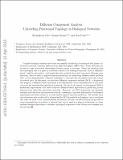| dc.contributor.author | Cho, Hyunghoon | |
| dc.contributor.author | Berger Leighton, Bonnie | |
| dc.contributor.author | Peng, Jian | |
| dc.date.accessioned | 2018-07-02T14:54:26Z | |
| dc.date.available | 2018-07-02T14:54:26Z | |
| dc.date.issued | 2015-04 | |
| dc.identifier.isbn | 978-3-319-16705-3 | |
| dc.identifier.isbn | 978-3-319-16706-0 | |
| dc.identifier.issn | 0302-9743 | |
| dc.identifier.issn | 1611-3349 | |
| dc.identifier.uri | http://hdl.handle.net/1721.1/116712 | |
| dc.description.abstract | Complex biological systems have been successfully modeled by biochemical and genetic interaction networks, typically gathered from high-throughput (HTP) data. These networks can be used to infer functional relationships between genes or pro- teins. Using the intuition that the topological role of a gene in a network relates to its biological function, local or diffusion-based “guilt-by-association” and graph- theoretic methods have had success in inferring gene functions [1, 2, 3]. Here we seek to improve function prediction by integrating diffusion-based methods with a novel dimensionality reduction technique to overcome the incomplete and noisy nature of network data. A type of diffusion algorithm, also known as random walk with restart (RWR), has been extensively studied in the context of biological networks and effectively applied to protein function prediction (e.g., [1]). The key idea is to propagate information along the network, in order to exploit both direct and indirect linkages between genes. Typically, a distribution of topological similar- ity is computed for each gene, in relation to other genes in the network, so that researchers can select the most related genes in the resulting distribution or, rather, select genes that share the most similar distributions. Though successful, these approaches are susceptible to noise in the input networks due to the high dimensionality of the computed distributions. | en_US |
| dc.publisher | Springer Nature | en_US |
| dc.relation.isversionof | http://dx.doi.org/10.1007/978-3-319-16706-0_9 | en_US |
| dc.rights | Creative Commons Attribution-Noncommercial-Share Alike | en_US |
| dc.rights.uri | http://creativecommons.org/licenses/by-nc-sa/4.0/ | en_US |
| dc.source | arXiv | en_US |
| dc.title | Diffusion Component Analysis: Unraveling Functional Topology in Biological Networks | en_US |
| dc.type | Article | en_US |
| dc.identifier.citation | Cho, Hyunghoon, Bonnie Berger, and Jian Peng. “Diffusion Component Analysis: Unraveling Functional Topology in Biological Networks.” Research in Computational Molecular Biology (2015): 62–64. | en_US |
| dc.contributor.department | Massachusetts Institute of Technology. Department of Electrical Engineering and Computer Science | en_US |
| dc.contributor.department | Massachusetts Institute of Technology. Department of Mathematics | en_US |
| dc.contributor.mitauthor | Cho, Hyunghoon | |
| dc.contributor.mitauthor | Berger Leighton, Bonnie | |
| dc.contributor.mitauthor | Peng, Jian | |
| dc.relation.journal | Research in Computational Molecular Biology | en_US |
| dc.eprint.version | Original manuscript | en_US |
| dc.type.uri | http://purl.org/eprint/type/ConferencePaper | en_US |
| eprint.status | http://purl.org/eprint/status/NonPeerReviewed | en_US |
| dc.date.updated | 2018-05-16T17:11:53Z | |
| dspace.orderedauthors | Cho, Hyunghoon; Berger, Bonnie; Peng, Jian | en_US |
| dspace.embargo.terms | N | en_US |
| dc.identifier.orcid | https://orcid.org/0000-0002-2713-0150 | |
| dc.identifier.orcid | https://orcid.org/0000-0002-2724-7228 | |
| mit.license | OPEN_ACCESS_POLICY | en_US |
